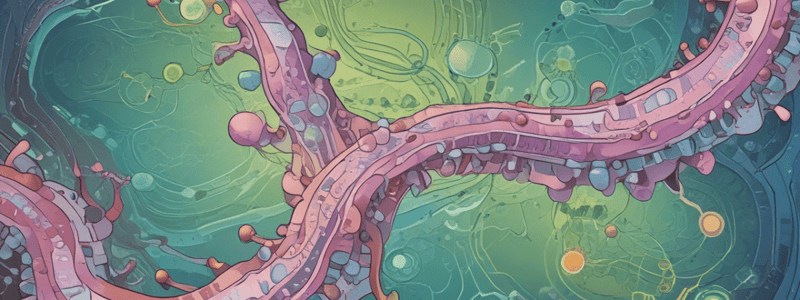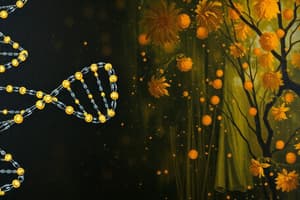Podcast
Questions and Answers
Which release factor recognizes the stop codons UAA and UAG?
Which release factor recognizes the stop codons UAA and UAG?
- RF-2
- RF-1 (correct)
- eRF-1
- None of the above
What do release factors cause to be released from the P site tRNA?
What do release factors cause to be released from the P site tRNA?
- The RNA polymerase
- The peptide chain (correct)
- The release factors themselves
- The ribosome
Which stop codons are recognized by eRF-1?
Which stop codons are recognized by eRF-1?
- UAA and UAG only
- All three stop codons (UGA, UAA, UAG) (correct)
- None of these
- UGA only
Where must release factors act to perform their function?
Where must release factors act to perform their function?
Which of the following statements is correct regarding stop codons and tRNAs?
Which of the following statements is correct regarding stop codons and tRNAs?
What is guided to the 30S ribosomal subunit by the Shine-Dalgarno sequence?
What is guided to the 30S ribosomal subunit by the Shine-Dalgarno sequence?
Which initiation factor mediates the binding of formylmethionine tRNA (fMet) to the peptidyl site?
Which initiation factor mediates the binding of formylmethionine tRNA (fMet) to the peptidyl site?
Which of the following components is part of the 30S subunit complex?
Which of the following components is part of the 30S subunit complex?
Where is the Shine-Dalgarno sequence generally located relative to the AUG start codon?
Where is the Shine-Dalgarno sequence generally located relative to the AUG start codon?
During elongation, what happens when the A site is filled?
During elongation, what happens when the A site is filled?
How many sites are there in a ribosome for elongation?
How many sites are there in a ribosome for elongation?
Which of the following binds to the P site during the initiation stage?
Which of the following binds to the P site during the initiation stage?
What is recycled by the third elongation factor (EF) during translocation?
What is recycled by the third elongation factor (EF) during translocation?
Flashcards are hidden until you start studying
Study Notes
Coupled Transcription and Translation in Bacteria
Termination
- STOP codons: UGA, UAA, and UAG have no corresponding tRNAs
- Release factors (RF) recognize STOP codons:
- RF-1 recognizes UAA and UAG
- RF-2 recognizes UGA and UAA
- eRF-1 recognizes all three STOP codons
- RFs act at the A site and require an occupied P site
- RFs cause the polypeptide chain to be released from the P site tRNA
- RFs then escape from the complex
Translation Initiation in Prokaryotes
Stage 2: Initiation
- Ingredients:
- 30S subunit of the ribosome
- Initiator tRNA (tRNAMet)
- mRNA
- Initiation Factors IF-1, IF-2, and IF-3
- One molecule of GTP
- 50S subunit of the ribosome
Formation of the Initiation Complex
- mRNA is guided to the 30S ribosomal subunit by the Shine-Dalgarno sequence
- Shine-Dalgarno sequence is complementary to a sequence in ribosomal RNA and is a ribosomal binding site in the mRNA
- Generally located 8 bp upstream of the AUG start codon
Formation of the Initiation Complex
- IF-1, IF-2, and IF-3 are initiation factors
- Sites on the ribosome:
- P site (peptidyl site)
- A site (aminoacyl site)
- E site (exit site)
Formation of the Initiation Complex
- Large 50S subunit combines with the 30S subunit to form the initiation complex
- Formylmethionine tRNA (fMet) binds to the peptidyl site (P site) mediated by IF-2-GTP
Translocation
- Elongation requires another elongation factor for translocation
- All amino acids move along one space, resulting in an empty A site
- When the A site is filled, the E site is emptied
- The 3rd EF recycles the first elongation factor
- This process continues until a STOP codon is reached
Elongation (BOTH eukaryotes & prokaryotes)
- All ribosomes have 3 sites: A, P, and E
- Initiator tRNA is in the P site
- Next amino acid is escorted to the A site
- The small subunit and base pairing "check" that the amino acid is correct
- Correct amino acid causes a conformational change and hydrolysis of bound GTP
- EFs are released, and a peptide bond is formed
Studying That Suits You
Use AI to generate personalized quizzes and flashcards to suit your learning preferences.




